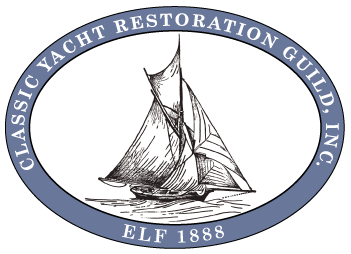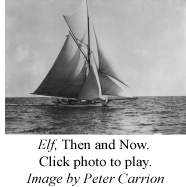| Classic Yacht Restoration Guild |



 |

"Ships are the nearest |
About Yacht Elf
Elf sported a topsail that reached 68' 6" into the air to grab every bit of wind available, and like other racing vessels of her day, her lines and rigging were adapted and innovated from successful merchant ship designs. Following a lively career as a gaff topsail cutter rigged racing yacht, Elf pioneered off-shore yacht cruising in 1893, by being the first small craft to successfully cruise round-trip from Marblehead, Massachusetts to Halifax, Nova Scotia, an achievement documented by Henry Howard in his 1946 autobiography. Some of Elf's rigging specifications are recorded in a notebook from the Lawley Boat Yard in 1888: Page from Lawley Yard dated 1888 - Elf's Stats Elf's hull specifications are as follows:
Elf was built at a time when George Lawley and Sons was one of several companies working to fill a fleet of small racing yachts, mostly cutter-rigged, to satisfy a growing demand among sailing-minded industrialists for ever faster boats, having modest hull size and extraordinary rigs. George F. Lawley was known to have been a pupil at the John Hawes Fund School, in South Boston in the 1870's, and studied naval architecture under John L. Frisbee. The Lawley yard built boats to their own designs, as well as to designs by the prominent designer Edward Burgess. Some of Elf's sister yachts, built within a few years, and sailed off Boston, are seen in contemporary photographs, and include the yachts Evelyn, Saladin, Hawk, Carmilla, Mildred, Hilda, Beatrice, Kathleen and Saracen. The first case of extreme over-canvassing is reputedly the yacht Kathleen, a "30-footer" designed by William Gardner and built in 1889. Like Elf, she sported a "clipper stem", which had not been widely used on earlier yachts but soon became the fashion on small yachts. After her racing career ended Elf was known to regularly cruise up and down the northeast, and later between New England and the Bahamas. She was formally entered in the early 20th century editions of Lloyd's Register of American Yachts. During the First World War, her externally fitted lead ballast was given up to support the war effort, and eventually a steel keel was fitted; her sail area was reduced and her rigging was modified. She underwent several name changes over the years, including Blue Cloud, Flying High, and Paz. Elf was then purchased in 1932 by Gus and Vida Van Lennep, who founded the Chesapeake Bay Maritime Museum in 1965 and who have ardently supported Elf�s restoration. Rick Carrion, founder of the Classic Yacht Restoration Guild (CYRG), acquired the boat in 1971, in a somewhat dilapidated condition that belied her rich history, and has since championed her restoration under the expertise of master boat builder Graham Ero, proprietor of Graham Ero Wooden Boats, in Still Pond, Maryland. In recent years the CYRG, under Rick�s direction, has been proud to have her listed on the National Register of Historic Places. In 2005, Rick gave a presentation about the restoration work to the Union League - you can see it here: Elf Restoration PDF Photographs of the progress made during 2006-2007 period as well as historical photographs can be found here: Elf Photos Elf historical records can be viewed here: History. The Woods of ElfLike any other boat, Elf was built with a collection of different kinds of woods, each selected for its unique characteristics. Sixteen different woods were used (not counting the white pine tooth picks in the galley!), some farily common, some fairly exotic. Angelique - Dicorynia quianensis Ash - Traxinus americana Atlantic Northern White Cedar - Chamaecyparis thyoides Black Locust - Robinia pseudoacacia Chestnut Oak - Quercus prinus Cypress - Cupressaceae Eastern Red Cedar - Juniperus virginiana Lignum Vitae - Guaiacum officinale Mahogany - Swietenia mahagoni North American Black Cherry - Prunus serotina Purple Heart - Peltogyne paniculata Sasafrass - Sassafras albidum Sitka Spruce - Picea sitchensis Southern Long Leaf Yellow Pine - Pinus palustris Western Douglas Fir - Pseudotsuga menziesii White Oak - Quercus alba |
|
The Classic Yacht Restoration Guild kindly thanks you for your continued support and generosity. |








